Working with Instagram influencers is a no-brainer these days as 68% of Instagram users come to the platform just to interact with creators.
In fact, influencer marketing has delivered up to 11X more ROI than other comparable marketing channels. According to research conducted by Influencer Marketing Hub, businesses earn $7.65 for every $1 on average they spend on influencer marketing.
A well-crafted Instagram influencer marketing strategy isn't as simple as gifting an influencer with a newly launched product or adding a few hashtags at the end of a post. It can be quite a minefield, especially in 2023.
Here we have put together the ultimate guide to Instagram influencer marketing that brands can use to seek and adapt to this dynamic evolution of the online marketing industry.
Table Of Content
- How Instagram Influencer Marketing Came Into Inception?
- Why Go For Instagram Influencer Marketing?
- Instagram Influencers Types
- Instagram Influencer Marketing Cost
- How To Build A Winning Instagram Influencer Marketing Strategy?
Click on the topic of your choice in this table of contents to jump straight it.
How Instagram Influencer Marketing Came Into Inception?
Instagram has a specialized section dedicated to business purposes. However, simply having a business profile and hard-selling won't suffice for Instagram marketing. Your followers will easily lose interest if you keep bombarding them with adverts.
That's why brands have to find innovative ways to engage with the audience on Instagram and find a way out. This is how Instagram influencer marketing took its place.
Interestingly, Instagram was the first social platform that enabled brands and influencers to collaborate for promotions.
Why Go For Instagram Influencer Marketing?
There are a plethora of influencers on all major social platforms– Twitter, YouTube, Facebook– but 93% of influencer marketing campaigns happen on Instagram. Why is that? Read on to find out!
Instagram Is Both The Influencers & Users Preference
59% of influencers find Instagram as the most effective social network when it comes to engaging with their followers.
As stated by Pew Research Center, Instagram is the second most popular social media platform on earth after Facebook. Nonetheless, 75% of Instagrammers take some action after coming across a sponsored post on the platform, and 60% use it to explore new products.
But influencer marketing is not just about users; it's about the influencers as well. And Instagram is a platform loved by both the creators and users due to its highly visual and interactive nature. So, it's a win-win for brands.
Instagram Influencers Marketing Has Higher Engagement Rates
A study found that brands get as much as four times more engagement on Instagram than on its parent company - Facebook.
A micro-influencer from Twitter would receive an average engagement rate of about 1.45%. At the same time, an Instagram micro-influencer with the same amount of fans and followers can get up to 5.7% engagement rates on their posts – which is quite impressive.
Perhaps Instagram users love to see things in their feed that they can buy. Maybe the platform is better suited for brands than Facebook, which surprisingly has more users.
Instagram Users Have Disposable Incomes
To sell products using Instagram influencers marketing, you don't just need a highly relevant influencer; you also need an audience that can afford to buy from you.
And Instagram has a good chunk of users who are ready and able to open their wallets and bust out their credit cards to spend. Here are some supporting stats:
- 31% of people who make more than 75k/year are on Instagram
- 32% of people who make between 50k-74k/year are on Instagram
- 32% of people who bring in 30k-49k/year are on Instagram
Instagram Has Enormous Potential Reach For Influencer Posts Using The Right Hashtags
Instagram's potential reach is not just limited to its 1 billion active monthly users. Even the nano influencer with a few thousand followers has the potential to reach a larger audience than their own following.
But how? The answer is through hashtags.
Even though hashtags gained popularity on Twitter, they work much better with Instagram's format. Users frequently apply hashtags to discover new content. They also have the flexibility to follow the hashtags they wish to.
Hence, in the scenarios when an influencer doesn't have a large following base, the right hashtags help them reach a larger audience.
Thus, when you create an Instagram influencer marketing campaign, you and the influencer should take the time to research the best hashtags for the campaign.
Know more about 300+ Best Hashtags For Instagram In 2023
Instagram Influencers Types
Instagram influencers are categorized based on the size of their following. These types would be further used when you actually start planning and creating your Instagram influencer marketing campaign and also during budgeting.
Nano-Influencers
With a follower count of between 1k and 10k, nano influencers possess high engagement rates and a highly loyal audience.
Micro-Influencers
Having a follower count between 10k and 100k, micro-influencers are popular enough to guarantee increased sales and brand awareness.
Mid-tier Influencers
A powerful group of content creators with followers between 50k and 500k, mid-tier influencers offer a wide reach and slightly greater engagement than macro or mega-influencers.
Macro-Influencers
With an audience size between 500k and 1 million followers, macro-influencers include celebrities, TV personalities, athletes, or thought leaders. Brands can expect a higher reach but not too great engagement rates with these types of influencers.
Mega-Influencers
Celebrities with more than a million followers fall under this category as they are highly known on social media for their celebrity status and have the power of generating a ton of engagement.
Instagram Influencer Marketing Cost
Below given are the pricing factors and numbers on how much budget you need when hopping into the ring of Instagram influencer marketing. However, the actual budget will be cumulative of these factors and usual market rates.
Factors That Impact Instagram Influencer Marketing Cost
1. Size Of Following: The more followers an influencer has, the more it's going to cost you.
2. Engagement Rates: The engagement that the influencer generates on organic versus sponsored posts.
3. Influencer's Niche: For a niche with a massive number of Instagram influencers, the price of influencers will be comparatively less as there is a vast pool to choose from.
4. Content Format: Instagram influencers charge according to formats of the sponsored content, such as shoutouts, feed posts, stories, reels, etc., as each format takes a different amount of time to create. The more resources and time used to produce the content, the more expensive it will be.
You would almost pay 50% more for Instagram video content than you would for a feed post. Instagram influencers cost the least for stories, presumably due to their ephemeral nature.
5. Amount Of Content: Do you plan to create a one-off grid post or a series of stories over an extended period of time with the influencer? The longer the campaign, the higher the price will be.
6. Influencers Demand: If the influencer you are targeting is the one in demand and also a choice of several brands, they are naturally in a position to charge high.
7. Seasonality: If you want to work with influencers at the time of year when the demand of selling is the most such as new year's time, they are bound to push the cost up.
8. Reuse & Licensing Rights: Some influencers usually charge extra if you plan to re-share or repurpose their content.
9. Exclusivity: When collaborations consist of special conditions for influencers, they usually charge higher to agree to those terms. An instance of such a term includes a brand asking influencers not to collaborate with any competitors for a certain period of time after working with them.
10. Geography: Influencer marketing in the UK is priced reasonably, maybe because these marketers have been willing to pay.
Average Pricing Of An Influencer's Instagram Post In 2023
These prices are categorized based on the number of followers. Do note that this pricing comes with the qualification that factors such as production costs, creative mandates, timelines, etc., play a part in determining the final price.
| Type Of Instagram Influencer | Price Per Post |
|---|---|
| Nano-influencers | $10–$100 |
| Micro-influencers | $100–$500 |
| Mid-tier influencers | $500–$5,000 |
| Macro-influencers | $5,000–$10,000 |
| Mega-influencers | $10,000+ per post |
| Celebrities | Varies, but $1+ million isn't unheard of |
Source: Influencer Marketing Hub
How To Build A Winning Instagram Influencer Marketing Strategy?
Whether you have dabbled in a macro Instagram influencer marketing campaign or are just getting started with your first-ever influencer campaign, the step-by-step framework given here ensures you get the most bang for your buck from these partnerships. Copy our Instagram influencer marketing strategy or just take bits and pieces to design your campaign.
Step 1: Setting Realistic Goals
Let's get real here; if you are a small brand struggling to manage your finances, you won't get tons of sales overnight by spending millions of dollars on a celebrity Instagram influencer.
Instagram influencer marketing is only one part of your marketing plan. Fear not; success is still possible by setting realistic goals at the start itself, just as you would with any other marketing campaign.
Are you trying to generate more traffic to make more sales?
OR
Are you trying to build your following to expand your reach?
Of course, it's possible to achieve both goals with one Instagram influencer marketing campaign. But at certain times, your budget limits also put a bar on your goals.
Step 2: Figure Your Target Audience
This is the most crucial step of Instagram influencer marketing strategy, which is often missed as brands get caught up in the excitement of collaborating with influencers. This step is the one that will determine the ROI of your campaign.
Only by establishing a clear persona of your target audience will you be able to identify the influencer that best fits your brand. Determine if the followers of the influencer you are considering have demographics that match the profile of your target audience.
When you define your target audience accurately, you will be able to figure out which of the several influencers will bring the best results for your Instagram influencer marketing campaign.
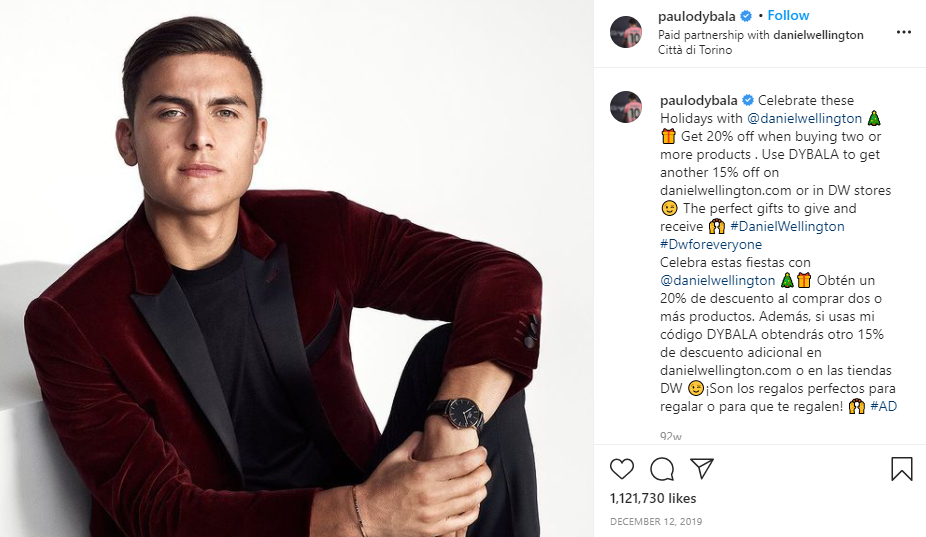
Image Source: Paulo Dybala Instagram
Step 3: Identify Influencers With The Right Brand Fit
You can now start looking for influencers on Instagram who will help you reach your ideal customers and fit your influencer marketing strategy.
Decide The Type Of Influencer
Firstly decide which types of Instagram influencers you want to work with, such as micro, macro, or celebrity influencers. Again this decision will heavily rely on your campaign goals.
-
If you want to generate a high level of engagement, consider working with micro-influencers. Though they have a small following, their audience is incredibly engaged with the content they produce.
-
If you want to generate reach, macro-influencers and celebrity influencers will better suit your campaign.
-
But if you want to launch a campaign that brings high engagement rates and reaches a large audience, it's best to work with a combination of micro and macro-influencers.
Find Influencers Profiles
By now, you will be well aware of the size of the influence you want to work with. So you should take time to research their social profiles. Keep your eyes out for Instagram profiles that fulfill these eight criteria. While scanning the profiles, ask yourself these questions:
-
Does the influencers' audience match your target audience?
-
Have they already collaborated with brands that offer similar products or services like yours?
-
Are they currently collaborating with one of your competitors?
-
Would their quality of content be a good representation of your brand?
-
Do they share genuine and personal stories with their followers?
-
What values do the influencers have?
-
Are their audiences engaging with their posts?
It's common for Instagram profiles to have a lot of followers, but with minimum engagements on their posts. Go through the comment section on the posts to see if they are positive and not just filled with spam ones. You might not want to partner up with an influencer who constantly receives negative comments, as your brand will then be linked to these comments.
Surprise, surprise, it's even possible to buy followers on Instagram. So watch out for such witty influencers.
- Is the influencer known for using similar products as yours?
If an influencer promotes a product or website that they are not known for using, their fans will quickly pick up on this and know that they are doing it as a part of the collaboration. This can negatively impact the influencer and your brand.
Doing your research intensely will help you find influencers that have the complete potential to become your brand ambassadors.
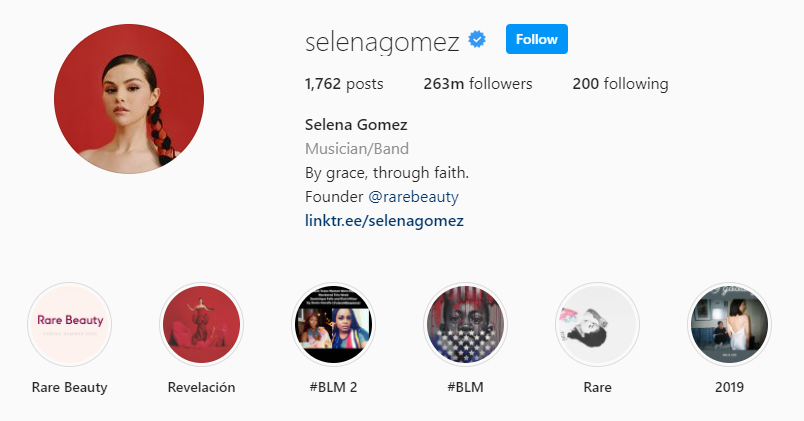
Image Source: Selena Gomez Instagram
Step 4: Pitch To Instagram Influencers & Communicate Your Collaboration Guidelines
It's now time to polish your pitching skills and start contacting Instagram influencers that you have shortlisted to get them on board.
Here are some tips on how you can craft the perfect pitch.
- Always personalize your pitch.
- Address why do you consider the influencer as the perfect fit for your campaign
- Tell them what they can gain from this collaboration. Never ask influencers to do anything for you in the first message. You can work out those details later.
- Share the next step.
After you have sealed deals with influencers, you should send them collaboration guidelines to avoid getting into conflicts later on. Here are the essential pointers to include in your Instagram influencer marketing campaign collaboration guidelines.
- Number of posts
- Deadlines
- Content-type
- KPIs to track the performance
- Content usage rights
- Disclosure guidelines
- Compensation terms
- Branded hashtags or links to include in created content
- Link in bio to be included or not
- Accounts to tag
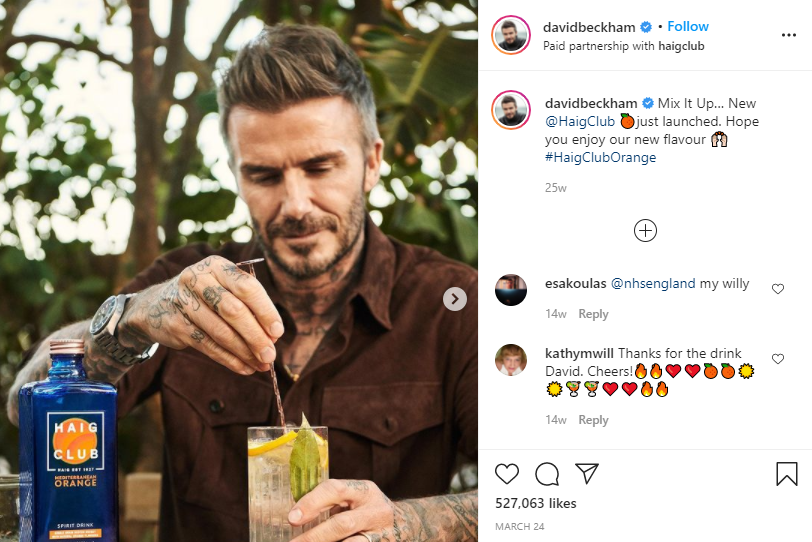
Image Source: David Beckham Instagram
Step 5: Measure The Success
A successful Instagram influencer marketing campaign is not complete without analytics. Whether you gifted your newly launched product to a micro-influencer or paid big bucks to an A-list influencer, you should know how they performed.
The success of your Instagram influencer marketing can be measured depending on your campaign goals. Use this guide to understand what data is required to measure and judge campaign effectiveness and set up tracking and reporting metrics based on your goals.
Brand Awareness
If brand awareness and exposure is your goal, then the most critical metric to consider is impressions.
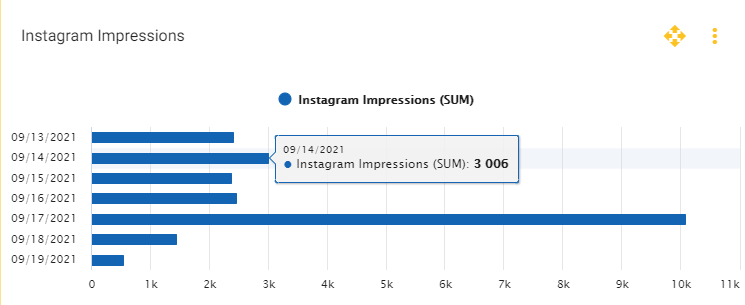
Brand Engagement
If your campaign goal is to build an engaged community, the engagements that your posts receive, such as likes, comments, shares, are your best measure of success.
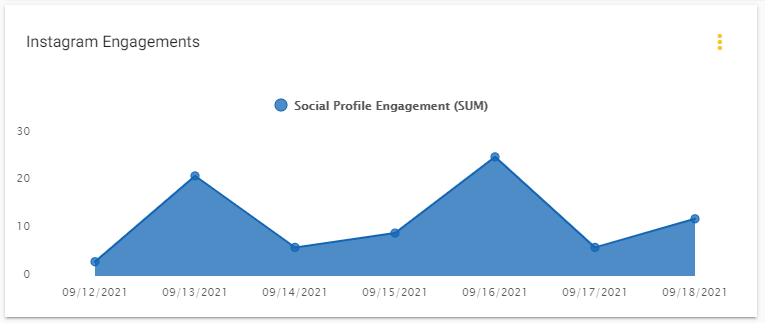
Social Media Growth
Measuring the effectiveness of an influencer campaign intended to drive social media growth involves manual reporting and tracking to attribute spurts of growth to a particular influencer. This is because the native social analytics tool will give you a clear understanding of overall trends but won't suffice to provide a detailed breakdown of your campaign.
In such scenarios, it's best to opt for social analytics tool such as Statusbrew that provides tons of metrics to track for a campaign. Measure every aspect of your campaigns from a single place and share live reports with your influencer and your team for a smooth collaboration.
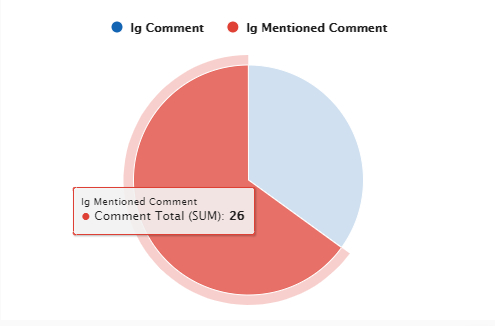
Website Traffic
When website traffic is the goal, the metrics such as new users, total sessions, total page views, time on site, and referral partners for a specific date range count.
Importantly, you should always create and use campaign URLs such as UTM links to track the source of website traffic and the success of campaigns.

Sales
Measuring the impact of an influencer campaign where the goal is to increase sales is achieved by attributing a discount code to every influencer. Thus, you will be able to track each sale, and it will become easy to assess the effectiveness of the campaign, as your audience will then use the unique code to purchase.
You can also use UTM links here to attribute which Instagram influencer is driving traffic that ultimately converts.
Content Creation
Measuring content creation is essential for running an influencer campaign since every other goal is met through content creation. It requires a manual count of the amount of specific content that has been created during the campaign period, which is quite a cumbersome process. Hence, it's better to track using a social analytics tool to get a bird' eye view.
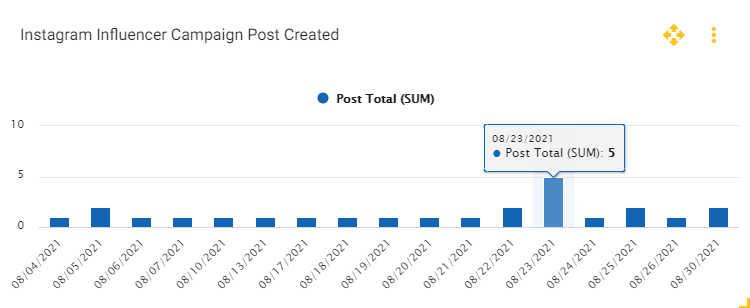
Reach New Target Markets
If your goal is to reach a new audience market, impressions, audience data, and sentiment are essential to measuring.
Audience data is a metric that can be very insightful during such campaigns but is not readily available using inbuilt analytics tools. Social reporting tools analyze audience data to its depth to understand who followers are, their interests, and demographics.

Audience sentiment is another crucial metric when reaching out to a new target market or launching a new product. It helps to determine what the audience is saying about your brand, the focus of the digital conversation, and if they have a positive response.
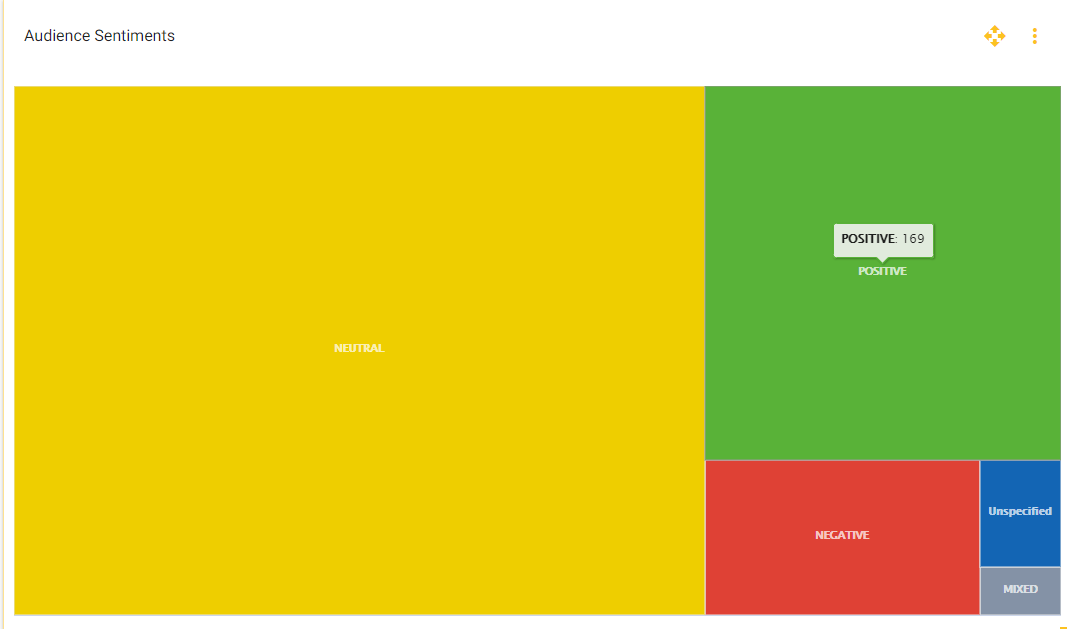
With this data in hand, you will be able to tweak future influencer campaigns to ensure they run smoother and more effectively.
At Last, Remember
Instagram influencer marketing is highly effective with the right implementation. Just ensure that it is a well-planned one.
And most importantly, have fun with your Instagram influencer marketing campaign. Remember that it's a creative space, so don't forget to be unique in the way you approach it.
Don't step back from connecting with your Instagram influencers and get their opinions. In addition to promoting your brand, they are experienced in the world of social media and may potentially have insights you might never think of.
Looking for a social analytics tool to track the performance of your influencers campaign? Try Statusbrew. With several ready-to-use reporting templates and total flexibility to customize these reports, Statusbrew will help you determine whether your social initiatives have led to positive results and where adjustments are needed to strengthen your marketing campaigns - in no time.
Statusbrew is an all in one social media management tool that supports Facebook, Instagram, Twitter, Linkedin, YouTube, and even Google My Business.

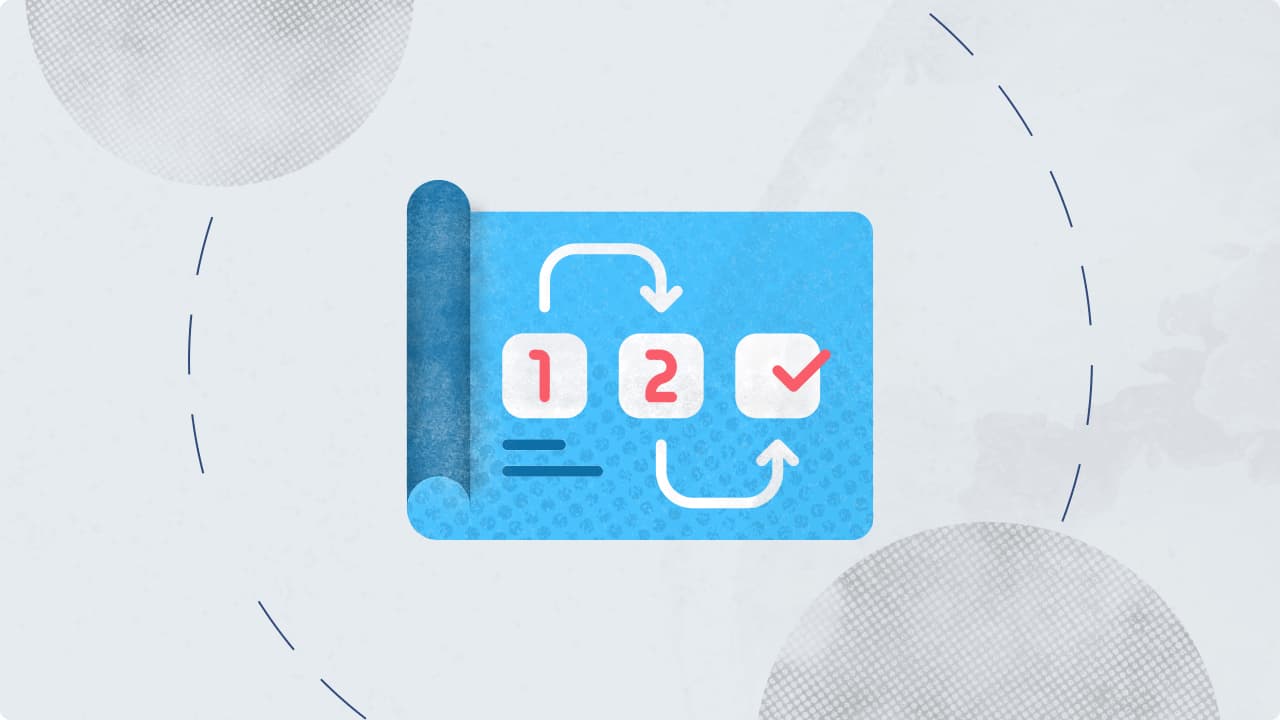


Explore the Statusbrew range of social media tools
Cancel anytime!